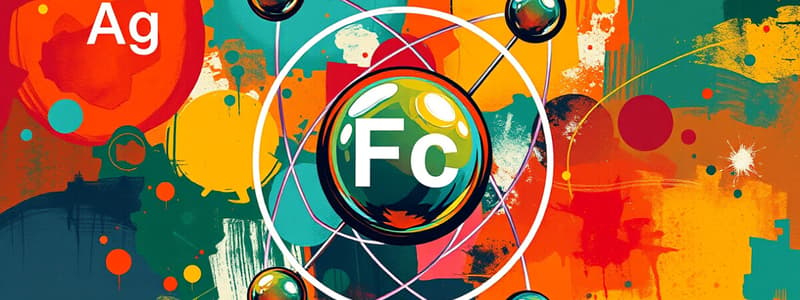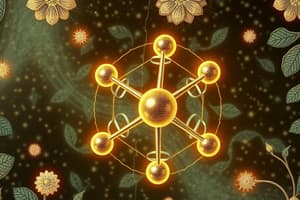Podcast
Questions and Answers
What are chemical elements?
What are chemical elements?
- Substances composed of only one type of atom (correct)
- Atoms that form ionic bonds
- Mixtures of different atoms
- Atoms with a net positive charge
Where are electrons located?
Where are electrons located?
Orbitals
What does an atomic number represent?
What does an atomic number represent?
The number of protons that the atom has, it identifies the element
What is the mass number?
What is the mass number?
What is the net electrical charge of every atom in the universe?
What is the net electrical charge of every atom in the universe?
What is a valence electron shell?
What is a valence electron shell?
What is an electron shell?
What is an electron shell?
Why does it matter whether an atom has an open or closed valence shell?
Why does it matter whether an atom has an open or closed valence shell?
For the first three electron shells, how many electrons are needed to produce a closed shell?
For the first three electron shells, how many electrons are needed to produce a closed shell?
By what means can an atom achieve a closed valence shell?
By what means can an atom achieve a closed valence shell?
What is an ion?
What is an ion?
What is a cation?
What is a cation?
What is an anion?
What is an anion?
How do ions form and how do they differ from atoms?
How do ions form and how do they differ from atoms?
What is an ionic bond?
What is an ionic bond?
What is bicarbonate's chemical formula?
What is bicarbonate's chemical formula?
What is the chemical symbol for Calcium?
What is the chemical symbol for Calcium?
What is the chemical symbol for Chloride?
What is the chemical symbol for Chloride?
What is the chemical formula for Hydrogen (free proton)?
What is the chemical formula for Hydrogen (free proton)?
What is the chemical formula for Hydroxide?
What is the chemical formula for Hydroxide?
What is the chemical symbol for Magnesium?
What is the chemical symbol for Magnesium?
What is the chemical formula for Phosphate?
What is the chemical formula for Phosphate?
What is the chemical symbol for Potassium?
What is the chemical symbol for Potassium?
What is the chemical symbol for Sodium?
What is the chemical symbol for Sodium?
What is an electrolyte?
What is an electrolyte?
What is the Octet Rule?
What is the Octet Rule?
What happens the closer an atom is to closure?
What happens the closer an atom is to closure?
What happens the further the electron shell is from the nucleus?
What happens the further the electron shell is from the nucleus?
Flashcards are hidden until you start studying
Study Notes
Chemical Elements
- Composed solely of one type of atom.
- Fundamental building blocks of matter.
Electrons
- Located in orbitals surrounding the nucleus of an atom.
- Each electron shell represents a specific energy level and potential energy storage.
Atomic Number
- Represents the number of protons in an atom, which identifies the chemical element.
Mass Number
- Defined as the total count of protons and neutrons in an atom's nucleus.
Electrical Charge
- All atoms in the universe are electrically neutral, meaning protons and electrons are in equal numbers.
Valence Electron Shell
- The outermost electron shell that determines an atom's reactivity.
Electron Shells
- Energy levels filled by electrons, with specific capacities:
- 1st shell: 2 electrons
- 2nd shell: 8 electrons
- 3rd shell: 8 electrons
Stability of Valence Shells
- Closed valence shells indicate stability and low reactivity.
- Atoms with open valence shells seek to complete them by gaining, losing, or sharing electrons.
Ions
- Formed when an atom or chemical group has unequal quantities of protons and electrons.
- Cations are positively charged, formed by losing electrons.
- Anions are negatively charged, resulting from gaining electrons.
Ionic Bonds
- Attractions occur between oppositely charged ions, forming ionic compounds.
Common Ions and Their Charges
- Bicarbonate (HCO₃⁻)
- Calcium (Ca²⁺)
- Chloride (Cl⁻)
- Hydrogen (H⁺, free proton)
- Hydroxide (OH⁻)
- Magnesium (Mg²⁺)
- Phosphate (PO₄³⁻)
- Potassium (K⁺)
- Sodium (Na⁺)
Electrolytes
- Substances that dissociate in water to form ions, essential for various biological functions.
Octet Rule
- Atoms are most stable when they have eight electrons in their valence shell (with the exception of the innermost shell).
- Indicates that atoms will not readily donate or accept electrons when stable.
Reactivity of Atoms
- Atoms closer to having a full valence shell are more reactive, aggressively seeking to achieve stability.
- The potential energy within an atom increases with the distance of the electron shell from the nucleus.
Studying That Suits You
Use AI to generate personalized quizzes and flashcards to suit your learning preferences.




